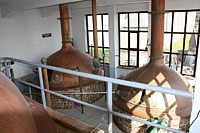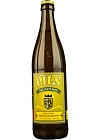Strubbe

In the heart of Western Flanders, not far away from the busy traffic route Roeselare-Ostend, is situated the peaceful town of Ichtegem. It’s a place that never plaid a significant role in Belgian history, but that was occasionally in the news because of the presence of 3 breweries on its territory.
Nowadays only one brewery is still operational. Situated in the shadow of the 17th century St-Michel’s Church, the traditional Strubbe Brewery, the Virgin of Ghent – as she used to be called, is as old as our country.
 In 1830, one Carolus Strubbe left the trading town of Tielt to try his luck in Ichtegem, a town well known for its flax industry. He became a farmer and brewer there: in summer, he tilled the land, and in winter he worked on the malt floor with his stirring barrel. At the time, most brewers grew their own raw materials, not only barley and grains, but some of them even grew their own hops. They made their barrels and tanks thereselves or at least restored them themselves; most of the time with oak from their very own trees. Due to this traditional method, there was a great variety of beer barrels in size and off course in content.
In 1830, one Carolus Strubbe left the trading town of Tielt to try his luck in Ichtegem, a town well known for its flax industry. He became a farmer and brewer there: in summer, he tilled the land, and in winter he worked on the malt floor with his stirring barrel. At the time, most brewers grew their own raw materials, not only barley and grains, but some of them even grew their own hops. They made their barrels and tanks thereselves or at least restored them themselves; most of the time with oak from their very own trees. Due to this traditional method, there was a great variety of beer barrels in size and off course in content.
Since its establishment, the brewery stayed in the possession of the family for six generations, from father to son. Carolus Strubbe was succeeded by his son Louis, who passed on the stirring stick to his son Medard, who changed the name of the brewery into ‘Brouwerij Strubbe’ (Strubbe brewery). Later on, he left the control of the day-to-day running of the brewery to his only son Aimé. After Aimé, two sons joined the brewery: Gilbert Strubbe, who became Master in the art of Brewing and his brother Etienne Strubbe, who was responsible for sales and administration. Today, the business is in hands of Norbert Strubbe, who followed in his fathers’ footsteps, and of Marc Strubbe, Gilbert’s son, who manages the production process. In ancient times, each town had at least one brewery. In 1900, Belgium had 6.7 million inhabitants, 2632 cities, 197821 bars and exactly 3223 breweries. Nowadays the number of operating breweries has dropped to less than 100. Due to the never ending investments in their own company all over the six generations, from the founder Carolus Strubbe, to Norbert and Marc Strubbe (so over a hundred and sixty five years), the Strubbe brewery managed to survive. Thinking of their prestige, many brewers opted not to invest in their own company, but yet in houses that they converted into bars, which were thus obligated to buy the beers of the investing brewery. They were wrong, because at the time of the turn of the century, the amount of bars begun to drop considerably, from 197821 in 1900 to 152200 in 1920 and 85000 in 1950. Nowadays only 30000 are left. Due to the loss of regular customers (and rent) on the one hand, and the technical and quality disadvantage in the production process on the other hand, many breweries were forced to close their company down.
In 1978 the most important investments took place since the establishment in 1978 when Aigle-Belgica (formerly Brewery De Meulemeester-Verstraete) was taken over and was dismantled by Piedboeuf (now Interbrew). All useful copper brewing machinery moved from Bruges to Ichtegem, where they have been cherished.
 In 1986, the open barm tanks were replaced by 4 cilindro-conical tanks of 150 hl, thanks to which one could work faster and more sterile and conservatives were no longer needed nor used. With these investments the brewery could expand her storage space and machinery, without harming the traditional production methods. Due to the increasing variety of local beers at the beginning of the nineties, another couple of cilindro-conical tanks were added.
In 1986, the open barm tanks were replaced by 4 cilindro-conical tanks of 150 hl, thanks to which one could work faster and more sterile and conservatives were no longer needed nor used. With these investments the brewery could expand her storage space and machinery, without harming the traditional production methods. Due to the increasing variety of local beers at the beginning of the nineties, another couple of cilindro-conical tanks were added.
Up to 1999, the brewery also had a lemonade and water production. Putting an end to this activity was necessary in order to give way to the expansion of the beer filling installation, again to improve the quality and packaging of the beer.
Until the end of the first world war, Strubbe only concentrated on high fermentation beers. It only concerned two beers called simple beer and high fermentation beer. The first had a 2% alcohol level, the second a 4 % alcohol level. Aimé Strubbe gradually switched over to the brewing of low fermentation beers, first there was ‘Bock’ and later on ‘Pils’, a conversion that cost a lot of money and energy but unfortunately that business did not turn a great profit. Luckily there was still the ‘Bruin Hengstenbier’ (~brown stallion beer), a beer that was loved for its sweet and sour special taste. This ‘hengsterbier’ was also the base for the in 1982 introduced ‘Ichtegem’s oud bruin’, with a 4.9% alcohol level, of which an improved version was launched after the 25 year old Marc Strubbe entered the business.
Share:



















